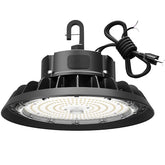Specification of High Bay LED Lighting
High bay leds. Warehouses, factories, gyms all need them - any place where high ceilings would make lighting a problem. They are almost the only winners in the town now. But, man, choose the right one based on these specification sheets? This is enough to make you want to pull out your hair. They make things not easy.

Here's the thing: Taking only the brightest or cheapest lamp is usually a mistake. You need to work for your people. In your space, there won't be crazy electricity bills, nor will there be flickering for a year. At this moment, I looked forward to it several times and saw what succeeded and what failed. Let me tell you the real exclusive news. What specifications are important so that you won't be burned to death.
1. Light output vs. Energy consumption
Ok. Lumens. That's just the amount of the original light. Brighter light usually means more lumens. Very easy. But don't just pursue the highest lumen count. What you really need to focus on is the lumen efficiency. That is lumens per watt (lm/W). Basically, how much electricity do you pay and how much light can you get? The higher the number here is, the better. This means that light works highly efficiently instead of wasting energy as heat. Better efficiency = lower electricity charges. It's just that simple. Always look for a good lm/W number.
So, exactly how much light do you need to reach the floor? We talk about foot candles (FC). A quiet rear passage may only require 20-30 FC. But where exactly do people do the specific work? You might need 50, 70, or even more. The key point is not to bombish the entire area with just one brightness level. Figure out what is needed where. Excessive lighting is just a waste of money and can make things shine uncomfortably. Seriously, connect them to motion sensors or dimmers. Lighting up an empty space is simply a waste.
40-50 FC: Used for ambient lighting in warehouses or general Spaces.
60-70 FC: Task lighting for workshops, assembly areas or detailed tasks.
80 FC: High-precision work, such as in manufacturing, inspection or sports facilities.
2. What does light look like
CCT (Correlated Color Temperature) refers to whether it appears warm (pale yellow, like an old-fashioned light bulb, think about 3000K) or cold (blue-white, more like sunlight, think about 5000K). For most workspaces, the middle position usually works best. 4000K (neutral white) or 5000K (cold white) seems to make people more alert and see more clearly. Select the content suitable for the work being carried out.
Then comes CRI (Color Rendering Index). This is very important. How accurate is the color presentation under this kind of light? 100 degrees Celsius is ideal daylight. If it's just about moving the box, a 70 or 80 CRI will do. But if you are doing anything that is important to color - painting, printing or inspecting goods - you really need a high color rendering index, 90 or higher. If there is no good CRI, red may appear brown and blue may look strange. It brings about real problems.
3. Where does the light go
A very bright lamp shone on the ceiling, but it was of no use to anyone. This is where optical components - reflectors or lenses - come into play. They guide the light. The distribution pattern defines how light propagates. Some lights are widely distributed in the large open area. Others focus on smaller beams, which are more suitable for passageways or guiding light downward from a height without completely losing the light.
You also need to match the Angle of the beam with the height of the ceiling. If your ceiling is very low, less than 20 feet, a wide beam of light, say 120 degrees, can scatter the light very well. If your ceiling is very high, 25 feet or higher, you need a tighter beam of light, perhaps 90 or 60 degrees, to direct the light to where people stand. Otherwise, the floor will be too dark. Most of the newer leds have lenses; They often offer better control than the old reflective lamps.
4. Power Stuff
The power factor (PF) should be high, close to 1 (for example, 0.9 or higher). Low power means that the lights will affect the power quality of your building and waste energy. The THD (Total Harmonic Distortion) should be very low (less than 20% is a good rule of thumb). High THD sometimes causes problems with other devices.
For love of all the good things, you should test the voltage. Is your house 120V? 277V? 480 V ? The light must match. Don't misunderstand. Finally, there is the driver. That is the small box that supplies power to the led. The quality of the driver determines how long the lights can last. Cheap lamps usually use cheap drivers, so if you are cheap on the drivers, you will install the lamps faster than you want. Flickering, dimming issues, and a completely failed driver are a nightmare.










